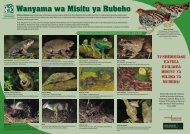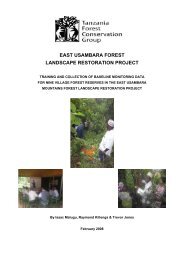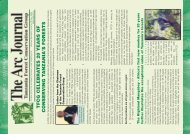Assessment of the biological values of different land cover types in ...
Assessment of the biological values of different land cover types in ...
Assessment of the biological values of different land cover types in ...
Create successful ePaper yourself
Turn your PDF publications into a flip-book with our unique Google optimized e-Paper software.
monoculture and Fischer‟s turaco (Tauraco fischeri), recorded <strong>in</strong> agr<strong>of</strong>orest, fallow <strong>land</strong> and mixed farm<strong>in</strong>g<br />
plots.<br />
The banded green sunbird Anthreptes rubritorques was <strong>the</strong> only bird species recorded that is endemic to <strong>the</strong><br />
Eastern Arc Mounta<strong>in</strong>s. The bird was recorded <strong>in</strong> <strong>the</strong> agr<strong>of</strong>orest sites <strong>of</strong> Misalai and Shambangeda village<br />
<strong>land</strong>scapes. Eastern Arc near-endemic bird species recorded <strong>in</strong>cluded Andropadus masukuensis, Anthreptes<br />
pallidigaster, Batis mixta, Poeoptera kenricki, Stactolaema olivacea and Artisornis moreaui.<br />
In terms <strong>of</strong> rare mammal species, <strong>the</strong> vulnerable species - black and rufous sengi (Rhynchocyon petersi) - was<br />
recorded <strong>in</strong>side <strong>the</strong> forest reserves. This species is also near-endemic to <strong>the</strong> Eastern Arc Mounta<strong>in</strong>s.<br />
In conclusion, <strong>the</strong> results <strong>of</strong> <strong>the</strong> study <strong>in</strong>dicate that <strong>the</strong> village <strong>land</strong>scapes <strong>in</strong> <strong>the</strong> East Usambaras support<br />
considerable biodiversity resources. These resources are important for conservation and for support<strong>in</strong>g <strong>the</strong><br />
livelihoods <strong>of</strong> local people. Apart from <strong>the</strong> village forest reserves, <strong>the</strong> o<strong>the</strong>r <strong>land</strong> use <strong>types</strong>, such as agr<strong>of</strong>orests<br />
and fallow <strong>land</strong>, support many valuable species.<br />
The results also suggest that many <strong>of</strong> <strong>the</strong> plant and vertebrate species endemic to <strong>the</strong> East Usambara may be<br />
restricted to <strong>the</strong> Government Forest and Nature Reserves <strong>the</strong>reby emphasiz<strong>in</strong>g <strong>the</strong> importance <strong>of</strong> <strong>in</strong>vest<strong>in</strong>g <strong>in</strong><br />
<strong>the</strong> conservation <strong>of</strong> <strong>the</strong> exist<strong>in</strong>g protected areas.<br />
The results highlight <strong>the</strong> importance <strong>of</strong> tak<strong>in</strong>g a <strong>land</strong>scape approach to conservation whereby conservation<br />
<strong>values</strong> should be recognized and enhanced across all <strong>land</strong> uses. Whilst protected areas, <strong>in</strong>clud<strong>in</strong>g village<br />
forest reserves, will cont<strong>in</strong>ue to harbor <strong>the</strong> vast majority <strong>of</strong> species <strong>in</strong> an area such as <strong>the</strong> East Usambaras,<br />
areas <strong>of</strong> agr<strong>of</strong>orestry can play an important role <strong>in</strong> provid<strong>in</strong>g habitat and corridors for some species.<br />
39






